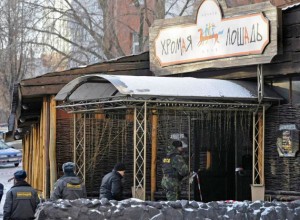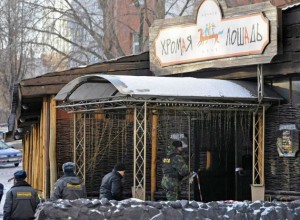 Once again, failure to follow fire safety and egress code requirements in a nightclub has resulted in a fire with multiple fatalities. The death toll from the December 4th fire at the Lame Horse in Perm, Russia currently stands at 112 with more than 100 people severely injured.
Once again, failure to follow fire safety and egress code requirements in a nightclub has resulted in a fire with multiple fatalities. The death toll from the December 4th fire at the Lame Horse in Perm, Russia currently stands at 112 with more than 100 people severely injured.
According to news reports, plastic sheeting decorated with twigs on the ceiling of the club was ignited by fireworks, and there was reportedly only one exit to accommodate hundreds of people. Sound familiar? This New York Times article compares the Perm fire with the 2003 fire at the Station Nightclub in West Warwick, Rhode Island, and this Wikipedia page compares it to the 1942 fire at the Cocoanut Grove Nightclub in Boston, Massachusetts.
The NFPA’s website has a wealth of information about fires in nightclubs and public assembly occupancies, including a list of the 10 deadliest public assembly and nightclub fires in U.S. history:
1903 – Iroquois Theater Chicago, IL – Deaths: 602
1942 – Cocoanut Grove nightclub, Boston, MA – Deaths: 492
1876 – Conway’s Theater, Brooklyn, NY – Deaths: 285
1940 – Rhythm Club dance hall, Nathez, MS – Deaths: 207
1908 – Rhodes Opera House, Boyerton, PA – Deaths: 170
1944 – Ringling Brothers and Barnum & Bailey circus tent, Hartford, CT – Deaths: 168
1977 – Beverly Hills Supper Club, Southgate, KY – Deaths: 165
2003 – The Station nightclub, W. Warwick, RI – Deaths: 100
1990 – Happy Land Social Club, Bronx, NY – Deaths: 87
1811 – Richmond Theater, Richmond, VA – Deaths: 72
And the 10 deadliest foreign (outside the U.S.) nightclub fires since 1970:
2000 – Disco/dance hall, Luoyang, China – Deaths: 309
2004 – Cromagnon Republic club, Buenos Aires, Argentina – Deaths: 180
1996 – Ozone Disco Club, Quezon City, Philippines – Deaths: 160
1971 – Club Cinq, St. Laurent du Pont, France – Deaths: 143
1983 – Alcala 20 disco, Madrid, Spain – Deaths: 81
1995 – Weierkang Club, Taichung, Taiwan – Deaths: 64
1998 – Disco/dance hall, Gothenburg, Sweden – Deaths: 63
2002 – Saigon International Trade Center, Ho Chi Minh City, Vietnam – Deaths: 61
1995 – Karaoke club, Urumqi, Xinjiang province, China – Deaths: 51
2002 – La Gorjira nightclub, Caracas, Venezuela – Deaths: 47
Many important code changes were adopted after the Station Nightclub fire in 2003. This NFPA Journal article explains in detail the process and the resulting changes, which affected sprinkler requirements, inspection of exits, crowd control, festival seating, and the use of pyrotechnics. In addition, a section specific to nightclub occupancies was added to the 7th edition of the Massachusetts State Building Code, and Rhode Island has also made changes, including eliminating a grandfather clause that exempted older buildings from meeting current building code requirements. See below for text from the Rhode Island State Building Code, SBC-1.
Definition of a nightclub per the Rhode Island State Building Code SBC-1:
NIGHTCLUB. An assembly occupancy in which people congregate in high densities for social entertainment such as drinking and dancing and characterized by some or all of the following unique characteristics:
1. Low lighting levels
2. Entertainment by a live band or recorded music generating above-normal sounds
3. Later-than average operating hours
4. Tables and seating (if any) arranged or positioned so as to create ill-definable aisles
5. Flexible fuel loading
6. A specific area designated for dancing
7. Service facilities for alcoholic beverages and food
8. Potential for consumption of legal or illegal drug use contributing to delayed reaction time to emergency events
9. High occupant load density
10. Movable furnishings
The Building Official shall have the authority to determine whether a proposed use is deemed a nightclub or a restaurant (see also section 903.2.1.2).
Sprinkler requirements for A-2 occupancies per the Rhode Island State Building Code SBC-1:
903.2.1.2 Group A-2. An automatic sprinkler system shall be provided for Group A-2 occupancies where one of the following conditions exists:
1. The fire area exceeds 5,000 square feet (464.5m2).
2. The fire area has an occupant load of 300 or more.
3. The fire area is located on a floor other than the level of exit discharge.
4. Nightclubs with an occupancy load in a single fire area of more than 100 occupants (see also Chapter 2 Definitions: Nightclub).
You need to login or register to bookmark/favorite this content.






Leave A Comment